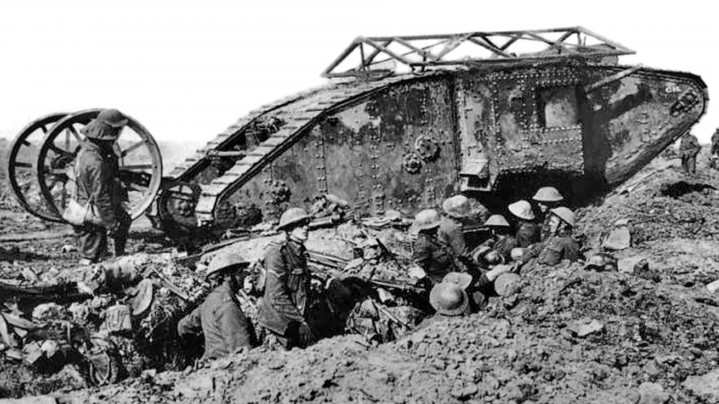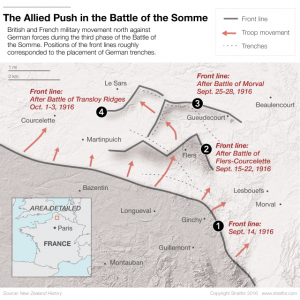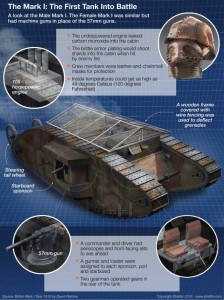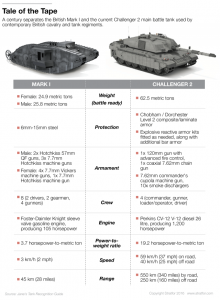 A British Mark I "male" tank pictured in September 1916, likely in reserve for the Battle of Thiepval Ridge. (Wikimedia Commons)
A British Mark I "male" tank pictured in September 1916, likely in reserve for the Battle of Thiepval Ridge. (Wikimedia Commons) One hundred years ago combustion powered armored war machines first took to the battlefield. Startfor did an excellent article in commemorating this historic development. Besides describing that event the article discussed the evolution of armored platforms back to the Roman Army and hit on some dynamics that still are with us today e.g. speed, weight mechanical reliability and incorporating the Infantry. It’s a worthy read. Republished with permission of Stratfor, “The Dawn of the Armored Fighting Vehicle”.
On the morning of Sept. 15, 1916, soldiers of the German 1st Army rushed to their defensive positions between Flers and Courcelette, on the Western Front. The lifting of the Allied artillery barrage typically presaged an infantry charge, and the defenders made their machine guns ready to cut down advancing British and French troops. But this time, instead of onrushing infantry, from the smoke and mist emerged grinding mechanical contraptions, spewing bullets and shells. The Germans poured machine-gun fire onto the strange, new vehicles lumbering across the ragged mud and wire of no man’s land, but the bullets had little effect. The day of the tank — a concept that would go on to define land warfare in the 20th century — had arrived.
The Battle of Flers-Courcelette was part of the ongoing Battle of the Somme in France and the first time that modern armored fighting vehicles were deployed in combat. Yet despite triumphant claims in the British press of a new weapon that would turn the tide of war by breaking the impermeable German lines, the tank’s initial deployment was largely inauspicious. Those first tanks were rushed into service and woefully underpowered for the terrain they would encounter while saddled with the weight of armor. Riddled with developmental problems and manned by crews with almost no training, of the 49 original Mark I tanks deployed to France 100 years ago, 36 set off from the British line of departure Sept. 15. Only 27 made it as far as German forward positions, and a meager six trundled as far as the secondary and tertiary objectives. Mechanical failure plagued the new invention, but the concept had been proved, and successive generations of tanks and tank tactics would turn a “mobile pillbox” into a battle-winning asset.
Analysis
The concept of a mobile, protected engine of war has been around for millennia. A means of collectively defending assault troops from projectile weaponry — with the potential inclusion of offensive capability — has fascinated the greatest minds of every era.
Greek hoplites employed bronze armor to good effect in phalanx formation — shield, helmet and greaves protecting a fighting man from the front and effectively nullifying the Persian advantage of massed archers. A good example of early armored tactics is the testudo (tortoise) formation employed by the Roman legions, specifically to protect against light projectiles as soldiers advanced. By interlocking full-length shields forward and overhead, legionnaires could easily deflect harrying fire. Though useful for closing on a fixed enemy position or defending from swarms of arrows, the formation was slow and limited the infantry’s ability to fight in close quarters.
The Romans also pioneered protective siege engines. These were designed to deliver troops to the enemy’s doorstep in one piece and were less dependent on individuals managing to maintain formation. Towers, galleries and other mobile fortifications protected assault troops from an enemy’s ranged weapons. In medieval warfare, mantlets and pavises, portable shelters or shields intended to protect clusters of troops from arrow fire, were common. A mantlet bore wheels for mobility, while the freestanding pavis was borne by one soldier.
In 1487, Leonardo da Vinci conceptualized an armored fighting vehicle, although his design was impractical because of the technology of the age. War engines or battlewagons pulled by horses were employed throughout history, but not until the industrial age did the armored fighting vehicle really come into its own. It needed the power of the internal combustion engine, mass-produced sheet metal and the technical sophistication to produce advanced running gear and automatic weaponry to make the true armored fighting vehicle feasible. The inspiration for the British tank was a mobile platform impervious to machine guns that could trample basic defenses, operating alongside infantry to breach and exploit enemy positions.
In June 1900, a young captain from the Corps of Royal Engineers had something of an epiphany, envisioning a possible solution to what he saw as the pressing military issue of the time: how to counter the withering, destructive capacity of the machine gun. He pursued his vision with vigor, becoming a respected tactician, innovator and staff officer. Maj. Gen. Ernest Swinton was a driving force when it came to the adoption and use of the armored fighting vehicle. He even coined the term “tank,” which became synonymous with the new invention. Swinton was not alone in his aspirations, but he did consider how tactics would need to evolve to make the armored fighting vehicle useful on the battlefield, informing subsequent tacticians such as British compatriot Col. J.F.C. Fuller and German Gen. Heinz Guderian.
The Evolution of the Tank
The appalling conditions of static trench warfare in World War I made life miserable for the fighting troops, and the incessant mud and rain also presented severe logistical problems. Moving large amounts of men and materiel by sea and rail was efficient. But getting ammunition, supplies or replacement troops from the railhead or port to the front lines was not. The constant passage of foot traffic and light vehicles made the largely unpaved roads and dirt tracks impassable. The wheeled vehicles of the time were inadequate for the conditions. Engines lacked the power to cope with broken terrain, and wheels simply sank into the muck. As a result, most armies continued to use horses and horse-drawn artillery for the duration of the war.
Innovators of the industrial age prided themselves on finding mechanical solutions to man’s problems, and the answer to moving heavy supplies to the front lines was continuous track technology — already prevalent in agriculture. That innovation was initially ignored by the British military establishment, but worsening battlefield conditions eventually resulted in trials of vehicles such as the Holt Caterpillar tractor, which was deemed suitable for hauling heavy artillery — but little else.
In a conflict known for its technological innovation and rapid prototyping, it is somewhat ironic that the inception of the tank was such a fraught and painful process. Early designs for armored fighting vehicles failed to capture the interest of the British or French hierarchy, and it fell to the Royal Navy to nurture the imaginatively titled “landships” project. At the insistence of Winston Churchill, then first lord of the admiralty, the Landships Committee sought to develop an armored fighting vehicle prototype. The aptly named “Little Willie” was tested Dec. 3, 1915, but was found insufficient for the breaching and crossing tasks envisaged. This led to the development of the now-classic rhomboidal tank design, which serves to this day as the insignia of the British Royal Tank Regiment. Following a successful demonstration during which the fledgling Mark I (christened “Mother”) defeated a number of typical Western Front obstacles, including low wire entanglements, cratered ground, trench systems and parapets, an initial order of 100 vehicles was made.
The development of the vehicles was shrouded in secrecy, and the terminology associated with them is attributed to Swinton, then a lieutenant colonel and heavily involved with the clandestine project. Some of the steel originally used on the Mark I design was repurposed from water boilers, and the original factory paperwork referred to the new inventions as “water carriers,” nomenclature adopted by workers who said they were manufacturing water tanks. Swinton made the “tank” code name official, then went on to give the two main types of Mark I vehicles their designations. “Male” tanks had a pair of Hotchkiss 57 mm Quick Firer naval guns in side-mounted sponsons, plus a brace of machine guns. “Female” tanks carried all machine guns and were, in effect, man-killers.
Tactical Analysis
The tank was originally conceived as an infantry support platform and moved at walking pace. Able to traverse trenches and breach wire obstacles, tanks relied on intimate support from ground troops. The steel armor offered some degree of protection from small arms, and the tanks’ weapons were effective in knocking out German gun positions. Successive generations of tanks, most notably the Mark V, sought to rectify the mechanical problems that plagued the early designs. Even so, tanks remained prone to mechanical failure throughout World War I. Crew comfort was an afterthought, and conditions inside the first tanks were infamously bad. It was not uncommon for a tank to stop midattack because its crew had passed out from internal fumes.
In September’s Battle of Flers-Courcelette, the Allies gained substantially more ground with about half the casualties than in a similar attack that they had staged in July. Though the addition of tanks to the attack was one factor in increasing their success, a general revision of battlefield tactics was underway, and other technologies were having a larger impact on the war. Better integration between infantry and artillery, aided by aerial spotters, was to prove pivotal. A more decentralized approach to command and improved liaison between formations also improved operational effectiveness on the ground. And in terms of troop tactics, the first major update to prewar methodology had been disseminated in May 1915. This paved the way for an updated training manual in February 1917 that effectively did away with “traditional” infantry tactics — namely, forming up in an extended line and advancing slowly toward the enemy. Several techniques from the revised manual are still employed by modern infantry platoons.
The infantry support tank served its purpose, and massed assaults combining armor and infantry continued. Spurred on by French and British innovations, the German army proceeded to make its own heavy tank. But it was the advent of the “cruiser” tank by the British in the 1930s that best illustrated where the future of armored warfare lay. Cruisers were lighter and faster than heavy tanks (often at the expense of protection and firepower) and operated more like traditional cavalry — exploiting battlefield gains and pursuing fleeing troops. Lighter tanks also proved useful for reconnaissance, and the British continued to experiment with tank design and tactics in the postwar years. Though the Allies led in the field of tank design in World War I, after the war, the Germans and the Russians recognized the untapped potential of armored warfare and invested heavily in design and employment.
The holy grail of tank design is a highly mobile platform with excellent protection and formidable armament, embodied by the German Tiger series of World War II. Tank technology and battlefield tactics matured during the years between the two wars, but the masterstroke was to fully utilize radio communications as an aid to command and control, leading to more effective maneuver and shock action. The German high command in World War II realized that an integrated force comprising infantry, armor, artillery and air assets operating in concert was devastating on the battlefield.
The impact of the tank on the World War I battlefield was very localized and, while they contributed to tactical success, tanks were not independently responsible for it. Still, where infantry proved vulnerable, the tank plowed on regardless, cleaving a path for skirmishers to follow. That in itself was revolutionary, and the advantage of defense held by the entrenched German army took a critical blow as a result.



